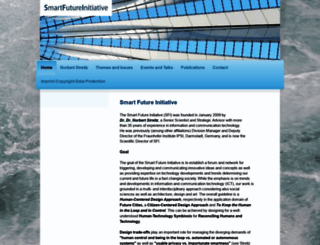- Home - Human-Centered Design Future Cities and Society
Page Load Speed
3.8 sec in total
First Response
538 ms
Resources Loaded
2.9 sec
Page Rendered
437 ms

About Website
Visit smart-future.net now to see the best up-to-date Smart Future content and also check out these interesting facts you probably never knew about smart-future.net
Smart Cities, Cooperative Cities, Citizen-Centered Design, Human in the Loop, Smart-Everything Paradigm, Ambient Intelligence, Privacy, Human-Computer Interaction.
Visit smart-future.netKey Findings
We analyzed Smart-future.net page load time and found that the first response time was 538 ms and then it took 3.3 sec to load all DOM resources and completely render a web page. This is a poor result, as 60% of websites can load faster.